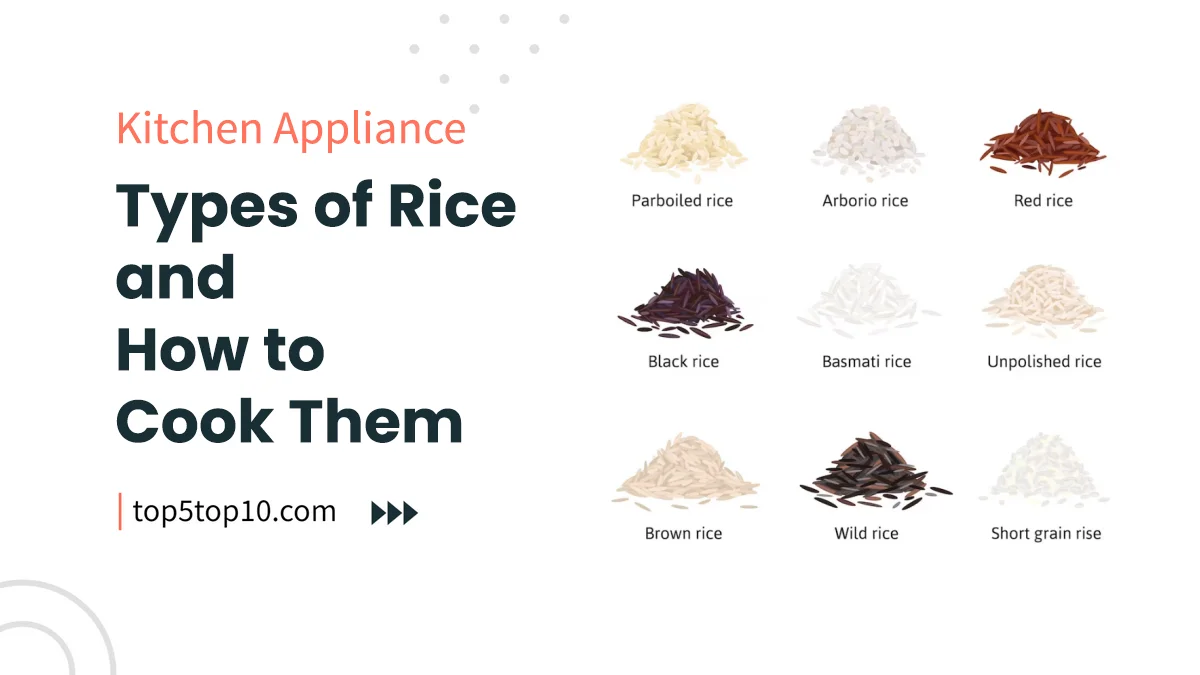
Different Types of Rice and How to Cook Them – Rice is a staple food in many cultures around the world, and its versatility makes it a favorite in countless dishes.
From fluffy long-grain rice to sticky sushi rice, each variety has its unique characteristics and cooking methods.
In this comprehensive guide, we’ll explore the different types of rice, how to cook them to perfection, and even provide some delicious recipes along the way.
Contents
1. Understanding Rice Varieties
Rice comes in a diverse range of varieties, each with its distinct flavor, texture, and best uses. Let’s explore some common and specialty rice types:
A. Common Rice Varieties
Rice comes in various shapes, sizes, and colors. Understanding the common rice varieties is the first step in selecting the right one for your dish:
- Appearance: Elongated grains with a length that is approximately four to five times their width.
- Texture: Remains fluffy and separate after cooking.
- Common Types: American long-grain, Basmati, Jasmine.
- Cooking Methods: Steamed, boiled, pilaf.
- Appearance: Slightly shorter and wider grains compared to long-grain rice.
- Texture: Tends to be more tender and slightly sticky when cooked.
- Common Types: Arborio (used for risotto), Calrose, Valencia.
- Cooking Methods: Risotto, paella, sushi.
- Appearance: Round and plump grains.
- Texture: Very sticky and clumps together when cooked.
- Common Types: Sushi rice, glutinous rice (used in desserts).
- Cooking Methods: Sushi, rice pudding, sweet rice dishes.
B. Specialty Rice Varieties
In addition to the common rice varieties, there are specialty rice types, each prized for its unique characteristics:
1. Wild Rice
- Appearance: Long, slender grains with dark, almost black color.
- Texture: Chewy and nutty with a distinct earthy flavor.
- Cooking Methods: Usually cooked with other rice varieties, added to salads, soups, or stuffing.
2. Red Rice
- Appearance: Reddish-brown grains.
- Texture: Similar to brown rice, slightly chewy.
- Flavor: Nutty and earthy.
- Cooking Methods: Boiled, used in salads, or as a side dish.
3. Black Rice
- Appearance: Deep purple to black grains.
- Texture: Sticky when cooked.
- Flavor: Nutty and slightly sweet.
- Cooking Methods: Used in desserts, rice bowls, and salads.
4. Sushi Rice
- Appearance: Short-grain, white rice.
- Texture: Sticky and slightly sweet when seasoned.
- Flavor: Neutral.
- Cooking Methods: Steamed and seasoned with rice vinegar, sugar, and salt for making sushi.
5. Sticky Rice
- Appearance: Glutinous or sweet rice with short, round grains.
- Texture: Extremely sticky and elastic when cooked.
- Flavor: Neutral, used in sweet and savory dishes.
- Cooking Methods: Steamed in bamboo baskets, used in Thai and Southeast Asian cuisine.
- Appearance: Long-grain or medium-grain rice with a pale yellow color.
- Texture: Remains separate and fluffy after cooking.
- Cooking Methods: Boiled, often used as a quick-cooking option.
2. Cooking Methods for Different Rice Types
Each rice variety requires a specific cooking method to achieve the desired texture and flavor. Here are the primary cooking methods for different types of rice:
A. Steamed Rice
Steaming rice involves cooking it with steam, which results in fluffy and separate grains. Here’s a general method:
| Rice Type | Water-to-Rice Ratio | Cooking Time | Steps |
|---|---|---|---|
| Long-Grain | 1.5:1 | 15-20 minutes | Rinse rice, bring water to a boil, add rice, reduce heat, cover, and steam. |
| Medium-Grain | 1.25:1 | 15-20 minutes | Rinse rice, bring water to a boil, add rice, reduce heat, cover, and steam. |
| Short-Grain | 1.1:1 | 10-15 minutes | Rinse rice, bring water to a boil, add rice, reduce heat, cover, and steam. |
| Basmati | 1.5:1 | 15-20 minutes | Rinse rice, bring water to a boil, add rice, reduce heat, cover, and steam. |
| Sushi | 1.25:1 | 15-20 minutes | Rinse rice, bring water to a boil, add rice, reduce heat, cover, and steam. |
| Sticky Rice | 1:1 | 20-25 minutes | Soak rice, steam in a bamboo basket or traditional steamer. |
B. Boiled Rice
Boiling rice is a straightforward method suitable for various rice types:
| Rice Type | Water-to-Rice Ratio | Cooking Time | Steps |
|---|---|---|---|
| Long-Grain | 2:1 | 18-20 minutes | Rinse rice, bring water to a boil, add rice, simmer, and drain. |
| Medium-Grain | 1.5:1 | 15-17 minutes | Rinse rice, bring water to a boil, add rice, simmer, and drain. |
| Short-Grain | 1.25:1 | 12-15 minutes | Rinse rice, bring water to a boil, add rice, simmer, and drain. |
| Arborio | 4:1 | 18-20 minutes | Sauté rice, add liquid gradually while stirring until creamy. |
| Jasmine | 1.5:1 | 15-17 minutes | Rinse rice, bring water to a boil, add rice, simmer, and drain. |
| Parboiled | 2:1 | 18-20 minutes | Rinse rice, bring water to a boil, add rice, simmer, and drain. |
C. Pilaf Rice
Pilaf is a cooking method where rice is sautéed in oil or butter before cooking:
| Rice Type | Water-to-Rice Ratio | Cooking Time | Steps |
|---|---|---|---|
| Long-Grain | 2:1 | 20-25 minutes | Sauté rice in oil, add liquid, simmer until liquid is absorbed. |
| Basmati | 1.5:1 | 15-20 minutes | Sauté rice in oil, add liquid, simmer until liquid is absorbed. |
| Arborio | 4:1 | 18-20 minutes | Sauté rice in butter, add broth gradually while stirring. |
D. Risotto Rice
Risotto is a creamy rice dish made using Arborio or other short-grain rice:
| Rice Type | Water-to-Rice Ratio | Cooking Time | Steps |
|---|---|---|---|
| Arborio | 3-4:1 | 18-20 minutes | Sauté rice in butter, add wine, gradually add broth while stirring until creamy. |
E. Fried Rice
Fried rice is a quick stir-frying method:
| Rice Type | Water-to-Rice Ratio | Cooking Time | Steps |
|---|---|---|---|
| Long-Grain | – | 10-15 minutes | Use day-old cooked rice, stir-fry with vegetables, meat, and seasonings. |
F. Rice for Sushi
Sushi rice is prepared with a specific seasoning:
| Rice Type | Water-to-Rice Ratio | Cooking Time | Steps |
|---|---|---|---|
| Sushi | 1.25:1 | 15-20 minutes | Rinse rice, cook, and season with rice vinegar, sugar, and salt. |
G. Rice for Desserts
Rice used in desserts, like rice pudding, requires a creamy and soft texture:
| Rice Type | Water-to-Rice Ratio | Cooking Time | Steps |
|---|---|---|---|
| Short-Grain | 1.25:1 | 30-40 minutes | Simmer rice with milk, sugar, and flavorings until creamy. |
3. General Rice Cooking Tips
Cooking rice to perfection requires attention to detail and some tried-and-true techniques. Here are some general rice cooking tips:
A. Proper Washing and Rinsing
- Importance: Removes excess starch, preventing clumping and stickiness.
- Method: Place rice in a fine-mesh strainer and rinse under cold water until the water runs clear.
B. Rice-to-Water Ratios
- Importance: Ensures the right balance between moisture and rice texture.
- Guideline: Use the water-to-rice ratios recommended on the package or per the cooking method.
C. Seasoning and Flavoring
- Importance: Enhances the taste of your rice dishes.
- Tips: Experiment with herbs, spices, and seasonings to match the cuisine you’re preparing.
D. Cooking Times and Techniques
- Importance: Determines the doneness and texture of the rice.
- Guidance: Follow package instructions for cooking times or the techniques specified for each rice type.
E. Resting and Fluffing
- Importance: Allows the rice to evenly distribute moisture and flavors.
- Method: After cooking, let the rice sit for a few minutes, then fluff it gently with a fork.
4. Recipes and Serving Suggestions
Now that you’re familiar with various rice types and cooking methods, let’s explore some classic and creative rice-based recipes and serving ideas:
A. Classic Dishes with Different Rice Types
1. Chicken and Rice (Long-Grain): A comforting one-pot meal with long-grain rice, chicken, and aromatic spices.
2. Risotto (Arborio): Creamy Italian rice dish infused with flavors like mushroom, saffron, or seafood.
3. Sushi Rolls (Sushi Rice): Delicious rolls filled with fresh fish, vegetables, and sushi rice seasoned with rice vinegar.
B. Creative Rice-Based Recipes
1. Stuffed Bell Peppers (Medium-Grain): Use medium-grain rice as a base for a flavorful stuffing mixture with meat and vegetables.
2. Rice Pudding (Arborio): A sweet dessert made by simmering Arborio rice in milk, sugar, and vanilla.
3. Black Rice Salad (Black Rice): A colorful and nutritious salad featuring black rice, vegetables, and a citrusy dressing.
C. Pairing Rice with Various Cuisines
1. Indian Cuisine (Basmati): Serve aromatic Basmati rice with curries, biryanis, or as a side dish.
2. Chinese Cuisine (Jasmine): Fragrant Jasmine rice pairs perfectly with stir-fries, steamed dishes, and sushi.
3. Japanese Cuisine (Short-Grain): Short-grain rice is essential for sushi, onigiri, and donburi bowls.
D. Vegan and Gluten-Free Rice Options
1. Vegetable Fried Rice (Any Rice): Create a vegan-friendly and gluten-free fried rice using your choice of rice.
2. Red Rice and Black Bean Salad (Red and Black Rice): A nutritious and gluten-free salad featuring red and black rice.
3. Sticky Rice Mango Dessert (Sticky Rice): A sweet and dairy-free dessert made with sticky rice, mango, and coconut milk.
5. Storing and Preserving Rice
To maintain the freshness and quality of your rice, follow these storage and preservation tips:
1. Proper Rice Storage: Store rice in an airtight container in a cool, dry place away from direct sunlight.
2. Extended Shelf Life and Freshness: For longer shelf life, consider vacuum-sealed bags or containers to prevent moisture and pests.
3. Avoiding Common Pitfalls: Keep an eye out for signs of spoilage, like off odors or insect infestations, and discard any compromised rice.
6. Rice for Health and Nutrition
A. Nutritional Benefits of Different Rice Types
1. Long-Grain Rice
Long-grain rice, including Basmati and Jasmine varieties, offers several nutritional benefits:
- Carbohydrates: Rich in carbohydrates, providing a good source of energy for daily activities.
- Low in Fat: Low in fat and cholesterol, making it a heart-healthy choice.
- B Vitamins: Contains essential B vitamins, such as thiamine and niacin, which aid in energy metabolism.
- Dietary Fiber: Provides dietary fiber that aids in digestion and promotes a feeling of fullness.
2. Medium-Grain Rice
Medium-grain rice, such as Arborio and Calrose, offers nutritional advantages:
- Carbohydrates: A moderate source of carbohydrates, offering sustained energy.
- Protein: Contains a small amount of protein.
- Vitamins and Minerals: Provides essential nutrients like niacin, magnesium, and phosphorus.
3. Short-Grain Rice
Short-grain rice, commonly used in Japanese cuisine, offers:
- Carbohydrates: Higher carbohydrate content for quick energy.
- Sticky Texture: The sticky texture is ideal for forming rice balls and sushi.
- Limited Nutritional Value: While it’s an energy source, it’s lower in vitamins and minerals compared to other rice types.
4. Specialty Rice (Wild, Red, Black)
Specialty rice varieties like wild rice, red rice, and black rice boast unique nutritional profiles:
- Antioxidants: Rich in antioxidants, which combat free radicals and support overall health.
- Fiber: Higher fiber content aids in digestion and provides a feeling of fullness.
- Phytonutrients: Contain various phytonutrients with potential health benefits.
5. Sushi Rice
Sushi rice is a light and healthy choice:
- Carbohydrates: Primarily a source of carbohydrates for quick energy.
- Low in Fat: Low in fat and cholesterol.
- Slightly Acidic: Rice vinegar seasoning gives it a slight acidity, enhancing its flavor in sushi dishes.
6. Sticky Rice (Glutinous Rice)
Sticky rice, often used in Asian desserts, offers:
- Gluten-Free: A gluten-free option suitable for individuals with gluten sensitivities.
- Glutinous Texture: The glutinous texture is ideal for creating chewy desserts.
- Limited Nutritional Value: Lower in essential nutrients compared to other rice types.
B. Dietary Considerations and Rice Choices
When selecting rice for your diet, consider the following dietary considerations:
- Gluten-Free: If you have gluten intolerance or celiac disease, opt for naturally gluten-free rice varieties like Basmati, Jasmine, and glutinous rice.
- Low Glycemic Index: For individuals monitoring blood sugar levels, choose rice with a lower glycemic index, such as Basmati or converted parboiled rice.
- Weight Management: If you’re focused on weight management, incorporate whole-grain rice varieties like brown or red rice, as they provide more dietary fiber and a greater feeling of fullness.
- Antioxidants: To increase your antioxidant intake, include black rice and red rice in your diet.
- Cultural and Culinary Preferences: Your cultural and culinary preferences play a significant role in your rice choices. Experiment with different types to discover your favorites.
7. Conclusion
Rice is a culinary gem that spans the globe, offering a wide range of flavors, textures, and culinary possibilities.
From the fragrant Basmati to the creamy Arborio and the nutritious black rice, each variety has its unique charm.
Whether you’re preparing comfort food, exotic dishes, or delightful desserts, there’s a rice variety to suit your needs.
The versatility of rice knows no bounds, making it an essential ingredient in countless cuisines.
It’s a canvas upon which flavors, spices, and ingredients blend harmoniously.
As you explore the world of rice, remember that the possibilities are endless, and there’s always a new culinary adventure waiting for you in your kitchen.
8. References and Resources
For further information on rice varieties, cooking techniques, and recipes, consider these references and resources:
Different Types of Rice and How to Cook Them FAQs
What are the different types of rice, and how do they differ from each other?
There are numerous types of rice, but the main categories include white rice, brown rice, long-grain rice, medium-grain rice, and short-grain rice.
White rice is polished to remove the bran layer, while brown rice retains the bran, making it healthier. Long-grain rice has a slender shape, while short-grain rice is shorter and plumper.
Each type has unique flavors and textures, making them suitable for various dishes.
How do I cook white rice to perfection?
To cook white rice, rinse it in cold water to remove excess starch.
Then, combine one cup of rice with two cups of water, bring it to a boil, reduce the heat to a simmer, cover, and cook for 15-20 minutes.
Fluff the rice with a fork before serving.
What's the difference between brown rice and white rice, and how do I cook brown rice?
Brown rice retains the bran layer, which makes it more nutritious but also results in a chewier texture and a nuttier flavor compared to white rice.
To cook brown rice, use a 2:1 ratio of water to rice, and simmer it for about 45-50 minutes. It requires a longer cooking time than white rice.
How do I cook long-grain and short-grain rice?
Long-grain rice is ideal for dishes like pilaf and tends to stay separate and fluffy when cooked.
Use a 2:1 ratio of water to rice and cook for 15-20 minutes. Short-grain rice, often used in sushi, is stickier and more suitable for dishes that require a sticky texture.
Use a 1.25:1 ratio of water to rice and cook for 15-20 minutes, allowing it to rest for an additional 10 minutes after cooking.
Can I use a rice cooker to cook different types of rice?
Yes, a rice cooker is a convenient appliance for cooking various types of rice.
Many rice cookers have settings or presets for different rice types, making it easy to achieve perfectly cooked rice.
Simply follow the cooker's instructions for the specific type of rice you're preparing.
|
Related Tags
5 types of rice products, different types of rice dishes, 4 types of rice, how to cook rice, most popular types of rice, 10 types of rice, types of cooked rice dishes
Last update on 2024-05-12 at 04:25 / Affiliate links / Images from Amazon Product Advertising API



















